1Department of Biological Sciences, College of Science, King Abdulaziz University, Jeddah. Saudi Arabia.
2Department of Biology, College of Sciences University of Jeddah, Jeddah, Saudi Arabia
3Department of Biology, College of Science and Arts, Northern Border University, Rafha, Saudi Arabia
4Department of Biology, College of Science, Taif University, Taif, Saudi Arabia.
Corresponding author email: w.alotaibi@tu.edu.sa
Habeeb M. Al-Solami Orcid Id: https://orcid.org/0000-0002-1276-4871
Shatha AlQurashi Orcid Id: https://orcid.org/0009-0009-4763-4063
Khalid Khairou Orcid Id: https://orcid.org/0000-0002-8642-4626
Abdullah Alghamdi Orcid Id: https://orcid.org/0000-0002-6324-7938
Mohammad Aljameeli Orcid Id: https://orcid.org/0000-0003-4096-3568
Jazem A.Mahyoub Orcid Id: https://orcid.org/0000-0002-6778-4255
Wafa AL-Otaibi Orcid Id: https://orcid.org/0000-0001-6463-4262
Article Publishing History
Received: 15/02/2023
Accepted After Revision: 24/03/2023
Most of the murders are shrouded in mystery and the absence of a lot of forensic evidence that helps the authorities achieve justice and reveal the culprit. The insects present at the crime scene and their various stages remain clues and evidence that are very important in knowing and revealing the circumstances of the incident. Therefore, determining the species of insect related to forensic medicine is very important for each region separately. The present study was planned to survey of forensic insects species and its seasonal activity in Makkah governorate. The local white rabbits were used as a mammal closer to the human corpse. The work was carried out of one year from January to December 2019. During the survey, 15,757 flies of importance forensic insects were collected which represent three families: Muscidae (47.1%) ،Calliphoridae (30.0%); Sarcophagidae (22.6%), and Muscidae (47.1%).
In this study, four flies species were reported for the first time in Makkah City in the Kingdom of Saudi Arabia, these were Chrysomya albiceps; Ch. marginalis; Sarcophaga dux and Wohlfahrtia bella. The appearance of the W. bella species was first recorded in Saudi Arabia. The results showed the presence of forensic insects most of the time during the year, and there were significant differences in different months of the year, and the reason for this may be due to differences in climatic conditions, temperature, and relative humidity which are considered among the most important factors affecting the reproduction and spread of the insects.
Calliphoridae; Forensic Insects; Makkah; Sarcophagidae; Survey
Al-Solami H. M, Alqurashi S, Khairou A. K. S, Alghamdi A. G, Aljameeli M. M. E, Mahyoub J. A, Al-Otaibi W. M. First Survey and Identification of Forensically Important Entomofauna in Makkah City. Biosc.Biotech.Res.Comm. 2023;16(1).
Al-Solami H. M, Alqurashi S, Khairou A. K. S, Alghamdi A. G, Aljameeli M. M. E, Mahyoub J. A, Al-Otaibi W. M. First Survey and Identification of Forensically Important Entomofauna in Makkah City. Biosc.Biotech.Res.Comm. 2023;16(1). Available from: <a href=”https://bit.ly/3lP8z4V“>https://bit.ly/3lP8z4V</a>
INTRODUCTION
The science of forensic entomology is a comprehensive field in which arthropods and the judicial system interact. This science involves the significant application of insects and other arthropods to aid in legal investigations. Some species of insects have potential value in solving crimes, in terms of determining post-mortem interval (PMI), being the minimum time between death and the discovery of a body, and achieving justice through their relevance to legal medicine, for example in cases of a suspicious death, and/or by analysing the composition of insect species on a cadaver (Carvalho et al., 2004; Niederegger et al., 2012). This science plays an important role in determining the circumstances of crime and causes of death (Catts and Goff,1992; Sukontason et al., 2007; Khairou, 2022).
There are many species of blow flies (Diptera: Calliphoridae), including Lucilia sericata, Chrysomya albiceps, and Calliphora vicina, which can be used to detect some of the circumstances around a crime as these flies are often the first to arrive on a dead body, where they can lay their eggs and hatch into larvae that feed and are reared on the corpse (Smith, 1986; Higley and Haskell, 2009). There are other important species of flesh fly (Diptera: Sarcophagidae), such as Sarcophage sp., which provide significant information about the circumstances of crime (Grassberger and Reiter, 2002; Amoudi et al., 1994; Khairou, 2022).
There is a scarcity of environmental studies related to forensic entomology in the Kingdom of Saudi Arabia, which highlights the importance of the present study in enumerating the types of forensically important insects, defining them at the level of gender and species, and linking this information with the stages of decomposition of the body, as well as studying the seasonal correlations (autumn, winter, spring, and summer) and fluctuations in their population dynamics, and determining the quality of the correlation between population density and the prevailing climatic conditions in the city of Makkah over a year.
MATERIALS AND METHODS
This study aimed to identify the diversity and abundance of forensically important insects in the city of Makkah, which is located at the latitude and longitude coordinates 21°25′ N and 39°49′ W, respectively. The weather data used in this research was obtained from the General Authority of Meteorology and Environmental protection in Saudi Arabia. This data covered the whole of 2019, from January to December. The survey area was divided into several locations including the north, south, east, and center of Makkah ( Fig 1).
Figure 1: The site of collecting samples.
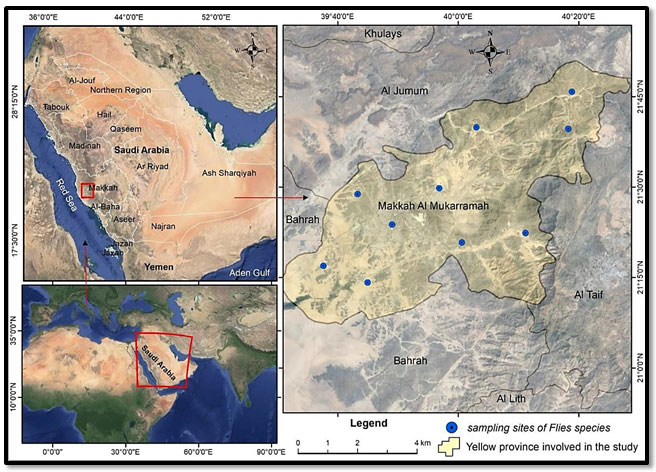
Cages and modifications: A ‘final flight’ trap was used in this experiment, which is a type of baited trap. The traps contain rabbit corpses of Oryctolagus cuniculus that were chosen to mimic the normal death case (human dead body). The rabbits were obtained from local shops in Makkah city, then killed with chloroform for this study. Some modifications were made to the final flight trap to implement this experiment with high efficiency: the bottom of the traps was removed and a cloth basket was inserted to collect samples (Fig. 2). Two of the traps were placed inside a cage made of acrylic (50 × 50 × 50 cm). The cage had two holes on the upper side in which to place the modified final flight traps (Fig. 3A). The acrylic cages were closed with a cement block from the lower side after placing the corpses inside. Then, the cages were put in plastic basins to prevent ants from reaching the cadavers (Fig. 3B).
Insect collection and classification: Insects were collected each day by carefully replacing the cloth basket, taking out the old one full of insects, and replacing it with a new one. The removed cloth baskets were full of live insects. Therefore, they were killed by freezing (-6°C) for one hour. Then, the specimens were incubated at room temperature for 10 minutes to stretch their muscles to preserve them (pinning). The samples were initially identified based on their morphological characteristics, depending on taxonomic description under a stereo light microscope (Leica EZ4 D) with a digital camera (B41 Olympus fitted with magnification power 32X and variable magnification) at the Insect Classification Unit in King Abdul-Aziz University. To aid specimen classification, some of the samples were put into labelled vials with Ethanol mixed with water (70% to 80%) and were sent to King Saud University to be classified by Professor Hathal, who used valid taxonomic keys (Borror et al., 1981).
Figure 2: The final flight trap to implement this experiment with high efficiency: the bottom of the traps was removed, and a cloth basket was inserted to collect samples.

Figure 3. a: Each cage with two holes on the upper side in which to place the modified final flight traps; b: Closed with a cement block from the lower side after placing the corpses inside the acrylic cages, then putting in plastic basins to prevent ants from reaching the cadavers.
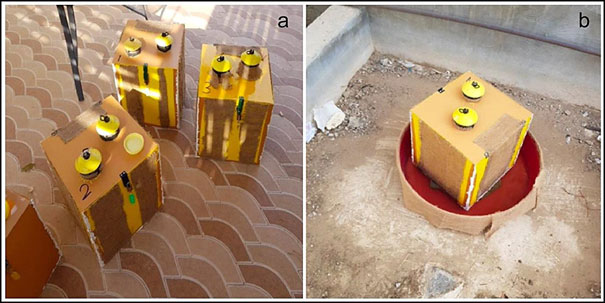
Statistical analysis: A comparison of the means of the population densities of forensically important flies was carried out using General Linear Models Procedure. All analyses were undertaken using SAS 2001 for Windows (IBM, Version 24) and all figures were drawn using Excel (Microsoft Corp, USA).
RESULTS AND DISCUSSION
The study aimed to investigate the diversity and abundance of forensically important insects during 2019 (from January to December) in the city of Makkah, west Saudi Arabia. The results identified five different species of Diptera, which were recorded for the first time in Makkah. The total number of different species of adult Diptera collected was 15,757 samples, across the three families of Sarcophagidae, Calliphoridae, and Muscidae. The number of Muscidae collected was 7,417 flies, representing the highest percentage of the total, at 47.1%, followed by Calliphoridae, with 4,773 samples forming 30.0% of the total, and finally the Sarcophagidae family, with 3,567 flies total and 22.6% of the total (Fig. 4).
Figure 4: The highest number of Muscidae with 7,417 flies forming 47.1 % and followed by Calliphoridae, with 4,773 samples forming 30.0% of the total, and finally the Sarcophagidae family, with 3,567 flies total and 22.6% of the total.
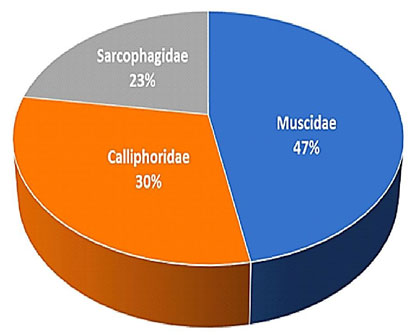
Calliphoridae family: In this part of the study, two species of Calliphoridae were recorded, belonging to the Chrysomya genus. Within species, Chrysomya albiceps (Wiedemann, 1817) was the most abundant and prevalent, at 87%, compared to Chrysomya marginalis (Wiedemann, 1830), at 13%. In regard to species description, Ch. albiceps is characterised by a metallic green colour, with silver frons and a single pair of membranous wings without any pigmentation. Whereas Ch. marginalis is characterised by metallic blue, and orange colour frons, and possesses a darkened anterior wing margin costal (C) and subcostal (Sc), the main defining feature used to identify this species (Fig. 5). Although, these species were recorded for the first time in Makkah, they have been identified in studies in many other cities in Saudi Arabia Arabia (Al-Shareef and Al-Qurashi, 2016; Al-Qurashi, 2016; Al- Shareef et al., 2016 AliKhan et al., 2018; Al-Jameeli et al., 2021; Khairou, 2022).
Regarding the Calliphoridae population, the findings showed that three peaks were recorded for this family in a year, over different seasons. The highest population by a significant margin was found in June, whereas the lowest was in November (Fig. 6). The third peak was in March, which was higher than November, but not significantly (Fig. 6). There were significant differences in Calliphoridae abundance across different seasons (Table 1). The other purpose of this part of the study was to investigate the effect of abiotic factors (temperature and humidity) on the population of Calliphoridae. The results showed a negative correlation, but not a significant one, between temperature and Calliphoridae population (R= – 0.136, P= 0.52). The relationship between humidity and the population of Calliphoridae was positive but not significant (R= +0.181, P= 0.397).
In regard to attraction, the results showed that the number of Calliphoridae forensic flies was significantly higher and they were more attracted to the corpse immediately after death; in the early decomposition stage (fresh); followed by the bloating stage of decomposition, which is considered the second level of decomposition (autolysis); and then active decay as the early third stage. In these stages, there was significantly less attraction and a smaller number of Calliphoridae. In the last stages of decomposition (advanced decay and skeletonisation), there were no recorded numbers of this family of fly.
However, there were fluctuations and significant differences between their population densities. Thes results are in agreement with Al-Jameeli’s (2021) study of the seasonal activity of Ch. albiceps showed that it was found continuously over the study period and this species is considered the dominant species. The species causes myiasis infection in its immature stages (larvae), occurring in tropical and subtropical areas, where they deposit their eggs on or near a wound or sore and, after hatching, the larvae burrow into the skin. The distribution and reproduction of Ch. albiceps flies have been observed in a variety of environments in terms of temperature and proximity to and distance above sea level (Al-Jameeli, 2021). Ch. albiceps is prevalent in the city of Riyadh, which is in the central region of Saudi Arabia (Al-Ahmed et al., 2006). In previous research, three and two peaks for Ch. albiceps activity have been recorded in Makkah and Jeddah over a year, respectively (Al-Ahmed et al., 2006).
Figure 5: Classification of morphological characteristics, depending on keys of taxonomic descriptions under a digital stereo microscope; A: Ch. albiceps is characterised by a metallic green colour, B: with silver frons, and C: a single pair of membranous wings without any pigmentation; D: Ch. marginalis is characterised by metallic blue, E: orange colour frons, and F: possesses a darkened anterior wing margin costal (C) and subcostal (Sc).
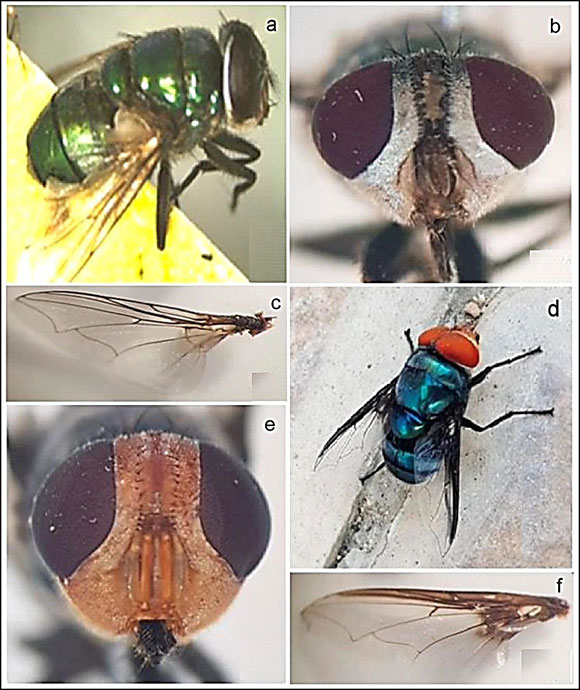
Figure 6: The relationship between temperature, humidity, and the population density of Calliphoridae in a year, over different seasons in Makkah city.
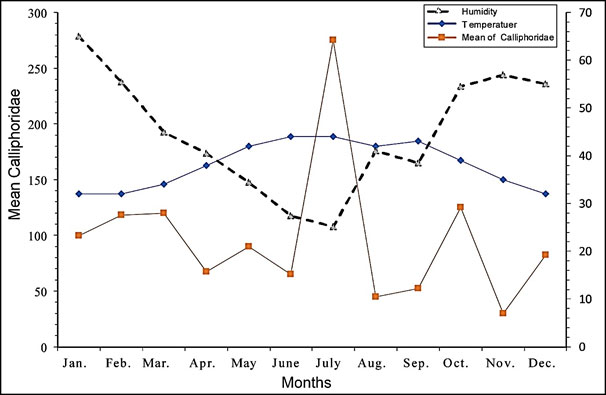
Sarcophagidae family: The data showed that there were two species of Sarcophagidae, Wohlfahrtia bella (Macquart,1836) and Sarcophage dux (Thomson, 1869), which were important for forensic science in Makkah. These were classified using their morphological characteristics, depending on keys of taxonomic descriptions (Borror et al., 1981) under a digital stereo microscope. It has been noted that three black lines appear clearly on the dorsal surface of the thorax from
front to back in all species belonging to this family (Fig. 7A). In addition, this species is distinguished by three clear features on the dorsal surface of the abdomen, the first being the presence of dark spots as circle-like on both lateral pleura of the abdominal region, as well as triangular marks along the midline of the abdominal region (Fig. 7B). The last feature relates to the size, shape, and colour of the abdomen, which is large, silver, and cylindrical in shape, with some grey squares, which alternate with the silver colour to give the impression of a chess
board (Fig. 7C). In the present study, two species of W. bella and S. dux, which belong to the Sarcophagidae family, were recorded in Makkah. This is the first recording of the W. bella species in Saudi Arabia, whereas the S. dux species have previously been observed and recorded in Riyadh, Saudi Arabia (Al-Misned et al., 2001). The Sarcophagidae family was shown to have a significant fluctuation in population density, reaching two peaks during the year in Makkah. These findings are consistent with many studies and past research conducted on Sarcophagidae (Al-Ghamdi et al., 2013; Al-Ghamdi et al., 2015). These two species, W. bella and S. dux, have also been found continuously in the city of Jeddah over a year (Algamdi, 2019).
The findings reveal that the mean number of W. bella was 141.22± 0.91SE and it was the most abundant and prevalent throughout the experiment time, with a 92% SD. The mean number of S. dux was 12.28± 0.25SE, at around 8% SD, making it less prevalent. The results show that these species appeared continuously and sequentially on the cadaver throughout the year, with significant differences in population density (Table 1). In addition, the study recorded two peaks of activity for Sarcophagidae in the city of Makkah: a small peak in March and a high peak in July of the year 2019. The means of the highest peak and second peak were a population density of 181.3 ±0.80 in July and 100.7±1.50 in March, respectively (Fig. 8). The mean of the lower population density was 22.50 ±0.90 in August, with significant differences between the population density over 2019 (Table 1). There was a negative correlation, though not a significant one, between the population density and temperature for Sarcophagidae (R= -0.136; P= 0.52), while the correlation with humidity was positive but not significant (R= +0.181; P= 0.397).
Figure 7: Classification of morphological characteristics, depending on keys of taxonomic descriptions under a digital stereo microscope; A: the appearance of three black lines clearly on the dorsal surface of the thorax from front to back in all species belonging to Sarcophagidae; B: the presence of dark spots as circle-like on both lateral pleura of the abdominal region, as well as triangular marks along the midline of the abdominal region in W. bella; C: large, silver, and cylindrical in shape, with some grey squares, which alternate with the silver colour to give the impression of a chess board in S. dux.

Figure 8: The relationship between temperature, humidity, and the population density of Sarcophagidae in a year, over different seasons in Makkah.

In regard to seasonal activity, the results showed a negative correlation and no significant difference between the seasonal abundance of Sarcophagidae and the temperature in Makkah. By contrast, in a study by Algamdi (2019), there was a positive correlation between seasonal abundance and temperature in Jeddah. These differences may be because of the geographical variance in the study areas. Over a year, between 10 and 12 generations of flies of diverse species have been recorded in warm regions, whilst in cold regions, reproduction is limited to only the warm months, though numerous species of fly have a period of diapause until conditions improve (Al Thabiani et al., 2016)
In general, there are several related factors and reasons that contribute to the increase in the population density and communities of various species of Sarcophagidae in Jeddah; some of these factors relate to location and climatic conditions, and others relate to certain habits, attitudes, and a low level of hygiene in poor neighbourhoods, as well as occasions when meat and sacrifices were common, resulting in increased organic and animal waste. This leads to the conclusion that the continued appearance of some species of Sarcophagidae in Jeddah is due to the spread of organic materials and blood and the low level of hygiene (Al-Solami, 2004).
Muscidae family: Within this family, one species was recorded, named Musca domestica (Linnaeus, 1758). Its average size is between 6 mm and 7.5 mm and it is dark grey in colour with four dark stripes of equal length on the dorsal of the thorax (Fig. 9A). In regard to the media veins (M), the first media M1 and the second media M2 have not reached the edge of the apical margin
(Fig. 9B). The head is roughly spherical in shape and bears a pair of antennae that hold a long spine called an arista, which has long hairs on both sides (Fig. 9C). The terminal segment of the leg has a pretarsus that bears two claws; beneath these claws are two pads, called pulvilli, between which is an elongated spine called an empodium (Fig. 9D). The pads typically contain glandular capillaries ending with hairs that secrete an oily substance that causes the tips of the hairs to adhere to inverted surfaces. These structures and this substance provide the traction and stickiness that allows the insects to climb smooth or horizontal surfaces. The monthly fluctuations in the population dynamics of M. domestica over a year in
Makkah were recorded. Table (1) and Figure (10) show the fluctuations in the population dynamics with the changes in seasonal factors, specifically humidity and temperature. The mean population density was 285.3 ±0.35 in August, the highest by a significant margin, compared with the mean population density in September, which was the lowest at 45.30 ±0.22. The mean of the highest abundance of M. domestica was 110 ±0.50 in January, which decreased to 56.80 ±0.15 in February. This decrease was followed by a continuous increase in the abundance of M. domestica to reach a small peak in June; the mean population density of the small peak was 218.8 ±0.50, which then declined to 120.3 ±0.13 in July. After this decline, the mean population density of M. domestica reached its highest peak in August, which was followed by simple fluctuation in population density from September to December 2019.
The results showed that the abundance of M. domestica rose gradually with progressive increases in temperature over the months from February to July. However, there was a positive, but not significant, correlation between the population density and temperature for Muscidae (R= 0.52; P= 0.65). In regard to the effect of humidity, it was recorded that the population of M. domestica increased gradually with decreasing humidity from February to June. Thus, there was a negative correlation between the population density and humidity, but not a significant one (R= -0.05; P= 0.78).
Figure 9: Classification of morphological characteristics, depending on keys of taxonomic descriptions under a digital stereo microscope; A: appearance of four dark stripes of equal length on the dorsal of the thorax; B: the first media M1 and the second media M2 NOT reached the edge of the apical margin; C: a pair of antennae that hold a long spine called an arista, which has long hairs on both sides; D: the terminal segment of the leg has a pretarsus that bears two claws; beneath these claws are two pads, called pulvilli, between which is an elongated spine called an empodium.
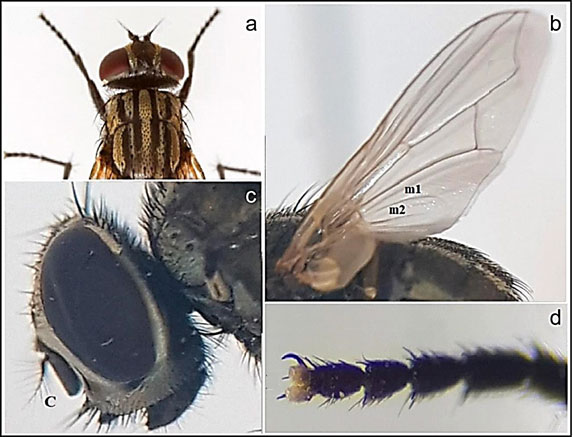
Figure 10: The relationship between temperature, humidity, and the population density of Muscidae in a year, over different seasons in Makkah city.

Table 1. The monthly abundance of flies’ species of forensic importance in Makkah, Saudi Arabia (Jan.-Des.2019)
| Months | Mean*±SE | ||
| Muscidae | Sarcophagidae | Calliphoridae | |
| 1 | 110.8±0.50 i | 79.25±0.50 d | 99.75±0.11 c |
| 2 | 56.80±0.15 k | 64.25±0.15 e | 118.0±0.25 b |
| 3 | 90.00±0.25 j | 100.7±1.50 b | 120.0±0.25 b |
| 4 | 149.8±0.75 g | 88.25±1.25 c | 67.50±0.75 e |
| 5 | 195.3±0.12 e | 24.25±0.25 h | 90.00±0.50 cd |
| 6 | 218.8±0.50 b | 83.75±0.50 c | 65.00±0.26 e |
| 7 | 120.3±0.13 h | 181.3±0.80 a | 275.0±0.27 a |
| 8 | 285.3±0.35 a | 86.75±0.25 c | 45.00±0.28 f |
| 9 | 45.30±0.22 l | 38.75±0.30 g | 52.50±0.15 f |
| 10 | 213.3±1.50 c | 22.50±0.90 h | 125.0±0.11 b |
| 11 | 206.8±0.50 d | 53.75±0.35 f | 30.00±0.25 g |
| 12 | 165.3±0.16 f | 65.75±0.50 e | 82.50±0.50 d |
| LSD | 3.23 | 5.38 | 3.00 |
| P | 0.0001 | 0.0001 | 0.0001 |
| * Means followed by the same letter are not significantly different according to LSD | |||
The study showed that adult M. domestica was present throughout the year, but at different densities depending on the prevailing climatic conditions. The seasonal activity of M. domestica Makkah City almost similar to observation of many researchers in Kingdom of Saudi Arabia (Al-Shareef, 2016; Alikhan et al., 2018; AL-Ghamdi, 2019).
CONCLUSIONS AND RECOMMENDATIONS
In this study, forensic insects in Makkah were identified using the morphological characteristics of adults, so we recommend the identification of insects at various stages of their life cycle, such as eggs, larvae, and adults using molecular identification techniques.
REFERENCES
Al-Ahmed, A. M., Al Dawood, A. S., & Kheir, S. M. (2006) Seasonal activity of flies causing myiasis in livestock animals using sticky traps baited with swormlure-4 in Riyadh region, Saudi Arabia. Scientific Journal of King Faisal University (Basic and Applied Sciences), 7(2), 1427-1435.
Algamdi, A. (2019) Seasonal Abundance of Flesh Flies Species in Jeddah Governorate and Evaluation the Toxicological Effects for Some Biopesticides against the Dominant Species. PhD Thesis, Department of Biology, College of Science, King Abdulaziz University, Jeddah, Saudi Arabia.
AL-Ghamdi K M. Abdulrahman A. Fargallah, Habeeb M. AL-Solami and Jazem A. Mahyoub (2013). Monitoring the population Fluctuation of the Prevalent Dipterous Fly Species Complex (Order: Diptera) by using malaise and yellow sticky traps in animal pens in Jeddah Governate, Western KSA. Biosciences, Biotechnology Research Asia. Vol. 10
Al-Ghamdi, K. M., Alikhan, M., Mahyoub, J. A., Alanazi, N. A., Al-Najada, A. R., Nassar, M. I., & Alfarhan, B. Z. (2015). Characterization of forensically important necrophagus flies (Diptera) of Jeddah, Saudi Arabia. Advances in Environmental Biology, 9(8), 58-72.
Al-Ghamdi, K. M., Faragallah, A. A., Saleh, M. S., Mahyoub, J. A., & Al-Solami, H. M. (2018). Monitoring the Population Fluctuation of the Prevalent Dipterous Fly Species Complex (Order: Diptera) by Using Malaise and Yellow Sticky Traps in Animal Pens in Jeddah Governorate, Western KSA. Biosciences Biotechnology Research Asia, 15(1), 131-138.
Alikhan Masroor, Khalid Al Ghamdi , Jazem A. Mahyoub and Naima Alanazi (2016). Public health and veterinary important flies (Order:Diptera) prevalent in Jeddah Saudi Arabia with their dominant characteristics and identification key. Saudi Journal of Biological Sciences; 25(8): 1648–1663.
Alikhan, M., Al-Ghamdi, K., Al-Zahrani, F. S., Khater, E. I., & Allam, A. M. (2018). Prevalence and salient morphological features of myiasis causing Dipteran flies in Jeddah, Saudi Arabia. Biosciences Biotechnology Research Asia, 15(1), 101-109.
Al-Jameeli, M. (2021) Studying myiasis-causing flies (Diptera: Calliphoridae): Survey, Molecular Identification and control the dominant species in Jeddah Governorate. PhD Thesis, Department of Biology, College of Science, King Abdulaziz University, Jeddah, Saudi Arabia.
Al-jameeli, M. M., Al-Ghamdi, K. M., Mahyoub, J. A., Sharawi, S. E., & Al-Ghamdi, A. (2021) Morphological and molecular identification of screwworm fly in Jeddah city: Genus Chrysomya (Calliphoridae). International Journal of Entomology Research, 6(5), 114-123.
Al-Misned, F. A., Amoudi, M. A., & Abou-Fannah, S. S. (2001) First record of Sarcophaga (Liosarcophaga) dux Thomson, 1868 (Diptera: Sarcophagidae) from Saudi Arabia. Pakistan Journal of Zoology (Pakistan), 33(4), 313-315\
Al-Qurashi, S. (2016) Seasonal Abundance and Distribution of Two Forensically Important Blowflies from Genus Chrysomya in Jeddah, Saudi Arabia. Alexandria science exchange journal, 37(July-September), 37, 350-357.
Al-Shareef, H., Zaki, M. K., & Ghannam, A. A. (2016). Estimation of postmortem interval for human corpse using the blowfly Chrysomya albiceps (Wiedemann, 1819) (Diptera: Calliphoridae) in Jeddah, Kingdom of Saudi Arabia. Advances in Environmental Biology, 10(12), 245-249.
Al-Shareef, L. A (2016) Houseflies (Diptera: Muscidae) associated with rabbit carcasses in Jeddah City, Kingdom of Saudi Arabia.” Advances in Environmental Biology, vol. 10, no. 12,
Al-Shareef, L. A., & Al-Qurashi, S. I. (2016) Study of some biological aspects of the blowfly Chrysomya albiceps (Wiedemann 1819) (Diptera: Calliphoridae) in Jeddah, Saudi Arabia. Egyptian Journal of Forensic Sciences, 6(1), 11-16.
Al-Solami, Habeeb Mansour (2004). Predominant flies between livestock pens and residential areas and the most important control methods in Jeddah Governorate, master’s thesis, Department of Biological Sciences, King Abdulaziz University.
Al Thabiani A., Al-Shami, S. A., Panneerselvam, C., Mahyoub, J. A., Murugan, K., Naimah, A., Ahmad, N. W., … & Benelli, G. (2016). Monitoring Diptera species of medical and veterinary importance in Saudi Arabia: Comparative efficacy of lure-baited and chromotropic traps. Karbala International Journal of Modern Science, 2(4), 259-265. https://doi.org/10.1016/j.kijoms.2016.09.001.
Amoudi, M. A., Diab, F. M., & Abou-Fannah, S. S. (1994). Development rate and mortality of immature Parasarcophaga (Liopygia) ruficornis (Diptera: Sarcophagidae) at constant laboratory temperatures. Journal of medical entomology, 31(1), 168-170.
Borror, D. J., De Long, D. M., & Triplehorn, C. A. (1981) An introduction to the study of insects, Saunders college publishing. Fort Worth, TX, 827-838.
Carvalho, L. M. L., Thyssen, P. J., Goff, M. L., & Linhares, A. X. (2004). Observations on the succession patterns of necrophagous insects on a pig carcass in an urban area of Southeastern Brazil. Anil Aggrawal’s Internet Journal of Forensic Medicine and Toxicology, 5(1), 33-39.
Catts, E. P., & Goff, M. L. (1992) Forensic entomology in criminal investigations. Annual review of Entomology, 37(1), 253-272.
Grassberger, M., & Reiter, C. (2002). Effect of temperature on development of Liopygia (= Sarcophaga) argyrostoma (Robineau-Desvoidy) (Diptera: Sarcophagidae) and its forensic implications. Journal of Forensic Science, 47(6), 1332-1336.
Higley L.G., & Haskell N.H. (2009) Insect development and forensic entomology. In: Byrd JH, Castner JL, editors. Forensic entomology: the utility of arthropods in legal investigations. 2nd ed. Boca Raton, Florida, USA: CRC Press, 389–405.
Niederegger, S., & Spieß, R. (2012). Cuticular muscle attachment sites as a tool for species determination in blowfly larvae. Parasitology research, 110(5), 1903-1909.
SAS (2001). SAS system for Windows. SAS Institute, Inc., Cary, NC., USA.
Smith, K. G. V. (1986). A manual of forensic entomology. Trustees of the British Museum. Natural History and Cornell University Press, London, 205.
Sukontason, K., Narongchai, P., Kanchai, C., Vichairat, K., Sribanditmongkol, P., Bhoopat, T., … & Sukontason, K. L. (2007). Forensic entomology cases in Thailand: a review of cases from 2000 to 2006. Parasitology Research, 101(5), 1417-1423.


